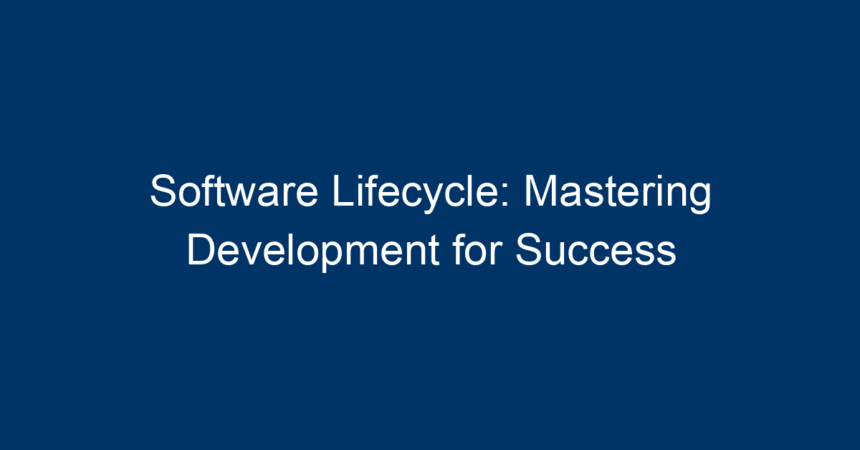In the fast-paced realm of technology, understanding the software lifecycle is essential for delivering successful software solutions. The software lifecycle encompasses all stages of software development, from conception to deployment and beyond. This guide aims to equip you with the knowledge to navigate each phase effectively, ensuring that your projects are not only completed on time but also meet user expectations.
What is the Software Lifecycle?
The software lifecycle is a systematic process that outlines the various stages of software development. It includes:
- Planning
- Requirements Analysis
- Design
- Implementation
- Testing
- Deployment
- Maintenance
By mastering these stages, software developers and project managers can improve product quality, enhance collaboration, and ultimately drive user satisfaction.
1. Planning: Setting the Stage for Success
The planning phase is critical to ensure that everyone is aligned and understands the project goals. During this stage, stakeholders define objectives and gather initial requirements. Key activities in this phase include:
- Defining the Purpose: What problem does the software aim to solve?
- Establishing Goals: Outline specific, measurable goals that the project must achieve.
- Identifying Stakeholders: Determine who will be involved and affected by the project.
By focusing on these aspects, teams can set a solid foundation for the subsequent stages of the software lifecycle.
2. Requirements Analysis: Capturing Needs
Once planning is complete, it’s time to dive into requirements analysis. This phase involves gathering and documenting detailed functional and non-functional requirements.
- Functional Requirements: What features should the software offer?
- Non-Functional Requirements: How should the software perform (e.g., security, scalability, usability)?
Engaging stakeholders through interviews, surveys, and workshops is crucial here. Clear requirements help bridge the gap between customer expectations and the development team’s output.
3. Design: Crafting the Blueprint
With the requirements in place, the next step is design. This phase turns abstract ideas into concrete plans.
Architecture Design
This includes defining the software’s overall structure and component interactions. Decisions made here will impact performance and scalability.
User Interface (UI) Design
A well-designed UI enhances user experience. Considerations here include layout, color schemes, and user navigation flow. Incorporating user feedback during this phase can prove invaluable.
4. Implementation: Bringing Ideas to Life
The actual coding occurs during the implementation phase, where designers become builders.
- Choosing a Programming Language: Select languages that align with project goals and team expertise.
- Iterative Development: Many teams use Agile methodologies here, breaking the project into manageable sprints for continuous delivery.
Collaboration tools and version control systems become essential in maintaining order and tracking changes during this phase.
5. Testing: Ensuring Quality
No software can be deployed without thorough testing. This phase involves verifying that the software meets all requirements and functions correctly.
Types of Testing
- Unit Testing: Testing individual components for correctness.
- Integration Testing: Ensuring different components work together.
- User Acceptance Testing (UAT): Validating the software with actual users.
Effective testing identifies issues early, saving time and cost in the long run.
6. Deployment: Making It Live
Once testing is complete and the software is deemed ready, the deployment phase begins. This involves releasing the software to the production environment.
Deployment Strategies
- Big Bang Deployment: The entire software is launched at once.
- Phased Deployment: The software is rolled out in stages, allowing for a controlled process.
Ensuring that users are informed and prepared for the new software can ease the transition.
7. Maintenance: The Ongoing Journey
Software doesn’t end at deployment. The maintenance phase is critical for keeping the software relevant and functional.
Types of Maintenance
- Corrective Maintenance: Fixing bugs that were not detected in earlier phases.
- Adaptive Maintenance: Adjusting the software to ensure continued functionality in changing environments.
- Perfective Maintenance: Enhancements and upgrades to improve performance or add features.
A robust feedback loop from users can guide maintenance efforts and help prioritize updates.
Leveraging Tools and Best Practices
To maximize success throughout the software lifecycle, consider leveraging tools and best practices:
Tools for Project Management
- Jira: For Agile project management.
- Trello: For visualizing tasks and improving team collaboration.
Version Control Systems
- Git: Essential for tracking and managing changes within the codebase.
Continuous Integration and Deployment (CI/CD)
Incorporating CI/CD tools allows for automated testing and deployment, enabling faster feedback and reduced release times.
Documentation
Maintaining clear documentation at every stage is key. It aids in knowledge transfer and ensures all team members are informed about project status and decisions.
Conclusion: Actionable Insights for Mastering the Software Lifecycle
Navigating the software lifecycle can seem daunting, but with careful planning and execution, it becomes manageable. Here are key takeaways to keep in mind:
- Invest Time in Planning: A well-defined plan sets the stage for a successful project.
- Engage Stakeholders Early: Continuous feedback helps keep the project on track.
- Prioritize Testing: Quality assurance throughout the lifecycle reduces long-term costs.
- Embrace Flexibility: Adaptation to changing requirements can lead to better outcomes.
- Document Everything: Clear documentation facilitates collaboration and knowledge transfer.
By mastering each stage of the software lifecycle, you position yourself for greater success in software development. Armed with this expert insight, you’re now ready to embark on your software projects with confidence and clarity.




